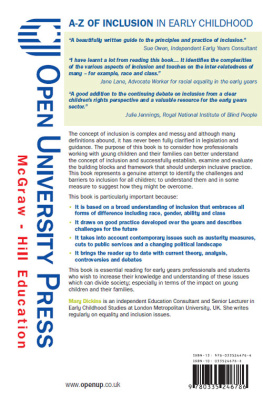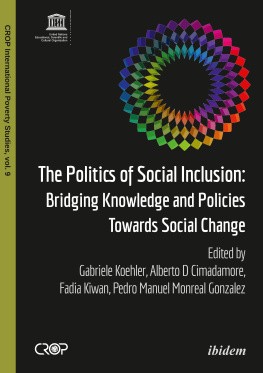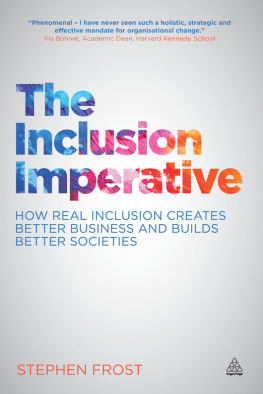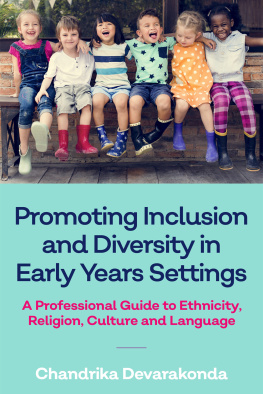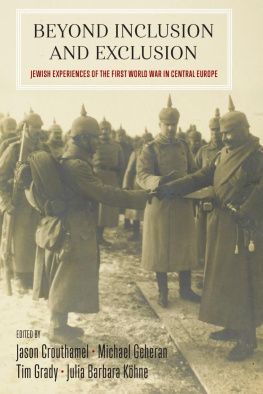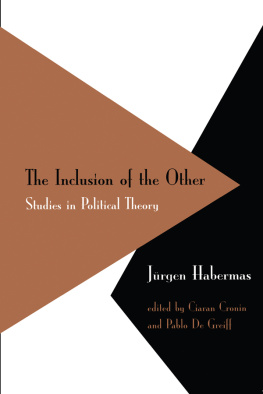Mary Dickins - A - Z of Inclusion in Early Childhood
Here you can read online Mary Dickins - A - Z of Inclusion in Early Childhood full text of the book (entire story) in english for free. Download pdf and epub, get meaning, cover and reviews about this ebook. year: 2014, publisher: McGraw-Hill International (UK) Ltd;McGraw-Hill Education;Open University Press, genre: Children. Description of the work, (preface) as well as reviews are available. Best literature library LitArk.com created for fans of good reading and offers a wide selection of genres:
Romance novel
Science fiction
Adventure
Detective
Science
History
Home and family
Prose
Art
Politics
Computer
Non-fiction
Religion
Business
Children
Humor
Choose a favorite category and find really read worthwhile books. Enjoy immersion in the world of imagination, feel the emotions of the characters or learn something new for yourself, make an fascinating discovery.
- Book:A - Z of Inclusion in Early Childhood
- Author:
- Publisher:McGraw-Hill International (UK) Ltd;McGraw-Hill Education;Open University Press
- Genre:
- Year:2014
- Rating:4 / 5
- Favourites:Add to favourites
- Your mark:
- 80
- 1
- 2
- 3
- 4
- 5
A - Z of Inclusion in Early Childhood: summary, description and annotation
We offer to read an annotation, description, summary or preface (depends on what the author of the book "A - Z of Inclusion in Early Childhood" wrote himself). If you haven't found the necessary information about the book — write in the comments, we will try to find it.
The key themes in inclusion are explored through an A - Z approach covering key concepts, theories / theorists, and figures.
A - Z of Inclusion in Early Childhood — read online for free the complete book (whole text) full work
Below is the text of the book, divided by pages. System saving the place of the last page read, allows you to conveniently read the book "A - Z of Inclusion in Early Childhood" online for free, without having to search again every time where you left off. Put a bookmark, and you can go to the page where you finished reading at any time.
Font size:
Interval:
Bookmark:

AZ of Inclusion in Early Childhood
AZ of Inclusion in Early Childhood
Mary Dickins

Open University Press
McGraw-Hill Education
McGraw-Hill House
Shoppenhangers Road
Maidenhead
Berkshire
England
SL6 2QL
email:
world wide web: www.openup.co.uk
and Two Penn Plaza, New York, NY 10121-2289, USA
First published 2014
Copyright Mary Dickins, 2014
All rights reserved. Except for the quotation of short passages for the purposes of criticism and review, no part of this publication may be reproduced, stored in a retrieval system, or transmitted, in any form or by any means, electronic, mechanical, photocopying, recording or otherwise, without the prior written permission of the publisher or a licence from the Copyright Licensing Agency Limited. Details of such licences (for reprographic reproduction) may be obtained from the Copyright Licensing Agency Ltd of Saffron House, 6-10 Kirby Street, London, EC1N 8TS.
A catalogue record of this book is available from the British Library
ISBN-13: 978-0-335-24678-6
ISBN-10: 0-335-24678-8
eISBN: 978-0-335-24679-3
Library of Congress Cataloging-in-Publication Data
CIP data applied for
Typeset by Aptara Inc., India
Fictitious names of companies, products, people, characters and/or data that may be used herein (in case studies or in examples) are not intended to represent any real individual, company, product or event.
Praise for this book
Mary Dickins has given us a book which is a beautifully written guide to the principles and practice of inclusion in young childrens care and education. For some this will be an introduction to, for others a reminder of, knowledge and skills which we have developed over many years but which are too often misunderstood or ignored. Through her alphabetical approach it is possible to address a huge number of issues in a very accessible way, either dipping into it as needed or reading from beginning to end as a story of how we can improve the experiences of young children in childcare, and every entry comes with a list of references to enable readers to take the subject further. Informing the whole book is her knowledge and experience of this issue and her passion to support the development of a shared vision and understanding of it. As she says: inclusion is not a fixed state... we all have responsibility and a role to play in challenging discrimination and oppression.
Sue Owen, Independent early years consultant
I have learnt a lot from reading this book and there is a lot to learn! Its scope is so enormous that inevitably it cannot cover everything, for example my pet topic of the power of assumptions! It identifies the complexities of the various aspects of inclusion and touches on the inter-relatedness of many for example, race and class. As readers dip into it I hope it will trigger further reading on particular issues and also stimulate more discussion of how institutional procedures and practices, deeply embedded in our society (the system), remain barriers to inclusion. We all need to identify, understand and break down such barriers so that every one of our precious children, wherever they are, feel they truly belong.
Jane Lane, Advocate worker for racial equality in the early years
Mary Dickins has long experience in early years and equality issues and writes from a defined value system. She encourages a proactive and anti-discriminatory approach which contributes to the development of - in her words - a shared vision, understanding and sense of purpose. Mary stresses the importance of individual responsibility and transfer of specialist skills to a mainstream context. This book is a good addition to the continuing debate on inclusion from a clear childrens rights perspective and a valuable resource for the early years sector, providing a framework to embed effective inclusive practice.
Julie Jennings, Royal National Institute of Blind People, UK
For my children Hannah and Theo
The term early years practitioner is used to describe all those who directly care for and educate young children, including childminders and nannies.
The term early years setting is used to describe any provision where young children are to be found.
The terms disabled child or disabled children are the preferred terms of reference because this is the terminology that disabled people have chosen. It is not the intention to define children in terms of what society sees as their shortcomings. The term disabled is used positively and forcefully by the disability movement to indicate pride and this is respected here.
The term special educational need is used because it is the wording of the relevant legislation and guidance.
The foundations of inclusive practice
Medical model thinking
Social model thinking
How we could use the process of inclusion to support equality
The listening cycle (adapted from McAuliffe 2003)
Playing and learning together
Enjoying the ride
Learning to take turns and share
Negotiating the territory
Supporting language development with action rhymes and songs
Learning about each other
Enjoying the company
Supporting learning through trust
Mealtimes as a social occasion
A chance to try something new
Superman takes a break
Friendships are important
Can I play with you?
Secure and trusting relationships
A chance to listen and share stories
Learning to respect each other
Learning from first-hand experiences
Taking a leap
Tuning fine motor skills
I would like to thank all the brilliant early years practitioners, managers, trainers, support staff and other professionals that I have met and worked with all over the country; especially my Early Childhood Studies students and colleagues at London Metropolitan University. You have all taught me so much and reminded me of how much I have still to learn. A special thank you to the children, staff and parents at Bemerton and Golden Lane Childrens Centres for allowing me to invade their space and take the photographs that enrich and enliven the pages of this book. Thanks to Ruth Thomson and colleagues at Nursery World who first gave me the opportunity to develop some of these ideas in the series AZ of Inclusive Practice. Thanks to my husband and my children for their tolerance and support and to my daughter Hannah Dickins and her friend Natalie Taylor for the production of the figures. Thanks to the Early Childhood Forum at the National Childrens Bureau for the inspirational definition of inclusion which provides the framework for the discussions in this book. Thanks to the Young Childrens Voices Network, also at the National Childrens Bureau, for the adaptation of the figure of the Listening Cycle and to Sue Owen for the extracts from the Participation and Belonging Conference Report. Thanks to all the academics, writers, thinkers, campaigners, researchers and organisations from whose insights and hard work I have drawn. Thanks to Jane Lane for her knowledge, wisdom and friendship as well as her case study. Finally, thanks to my editor, Fiona Richman, for her patience and understanding.
- Photographs from Bemerton Childrens Centre: Intro 1, B1, B2, C1, C2, F1, F2, G1, J1, K1, L1, R1, S2, S3
- Photographs from Golden Lane Childrens Centre: A3, B3, D1, D2, J2, P1, S1, Z1
- Figures were designed by Mary Dickins apart from Figure L2, The Listening Cycle, which has been adapted courtesy of the Young Childrens Voices Network at the National Childrens Bureau.
Font size:
Interval:
Bookmark:
Similar books «A - Z of Inclusion in Early Childhood»
Look at similar books to A - Z of Inclusion in Early Childhood. We have selected literature similar in name and meaning in the hope of providing readers with more options to find new, interesting, not yet read works.
Discussion, reviews of the book A - Z of Inclusion in Early Childhood and just readers' own opinions. Leave your comments, write what you think about the work, its meaning or the main characters. Specify what exactly you liked and what you didn't like, and why you think so.

